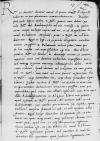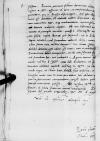Redditae sunt mihi cf. Ioannes DANTISCUS to Piotr GAMRAT shortly before 1538-09-28, CIDTC IDL 7199, letter lost⌊litteraecf. Ioannes DANTISCUS to Piotr GAMRAT shortly before 1538-09-28, CIDTC IDL 7199, letter lost⌋ Vestrae Dominationis Reverendissimae paucis ante diebus, ex aula reverendissimi domini Jan Latalski (*1463 – †1540), brother of Janusz Latalski, Voivode of Poznań; 1495-1525 Canon of Poznań, 1498-1505 Chancellor to Elizabeth of Austria, Queen of Poland; 1500-1525 Provost of the Gniezno Chapter, 1503-1525 Provost of the Cracow Chapter, 1504-1524 royal secretary, 1523-1525 Provost at the Poznań Chapter, 1525-1536 Bishop of Poznań, 1536-1537 Bishop of Cracow, 1537-1540 Archbishop of Gniezno (PSB 16, p. 562)⌊archipraesulisJan Latalski (*1463 – †1540), brother of Janusz Latalski, Voivode of Poznań; 1495-1525 Canon of Poznań, 1498-1505 Chancellor to Elizabeth of Austria, Queen of Poland; 1500-1525 Provost of the Gniezno Chapter, 1503-1525 Provost of the Cracow Chapter, 1504-1524 royal secretary, 1523-1525 Provost at the Poznań Chapter, 1525-1536 Bishop of Poznań, 1536-1537 Bishop of Cracow, 1537-1540 Archbishop of Gniezno (PSB 16, p. 562)⌋ ad me remissae, in quibus etiam recepi inclusas copias ad me et ad magnificum dominum Feliks (Szczęsny) Srzeński (Sokołowski, Szreński) (*1502 – †1554), due to his Polish origin, his nomination to starostwo of Marienburg aroused opposition in Royal Prussia; 1521 Cup-Bearer of Gostyń; 1526-1532 Castellan of Rypin; 1530 Starost of Płock; 1532-1554 Voivode of Płock; 1535 Starost of Marienburg (Malbork) (his candidacy was supported by Dantiscus); 1534 envoy of the Diet in Piotrków to Vilnius to King Sigismund I⌊palatinum MasoviaeFeliks (Szczęsny) Srzeński (Sokołowski, Szreński) (*1502 – †1554), due to his Polish origin, his nomination to starostwo of Marienburg aroused opposition in Royal Prussia; 1521 Cup-Bearer of Gostyń; 1526-1532 Castellan of Rypin; 1530 Starost of Płock; 1532-1554 Voivode of Płock; 1535 Starost of Marienburg (Malbork) (his candidacy was supported by Dantiscus); 1534 envoy of the Diet in Piotrków to Vilnius to King Sigismund I⌋, prius a Reverendissima Dominatione Vestra cf. Ioannes DANTISCUS to Piotr GAMRAT 1538-08-14 or shortly after, CIDTC IDL 7197, letter lost;
Ioannes DANTISCUS to Feliks (Szczęsny) SRZEŃSKI (SOKOŁOWSKI) 1538-08-14 or shortly after, CIDTC IDL 7198, letter lost⌊datarumcf. Ioannes DANTISCUS to Piotr GAMRAT 1538-08-14 or shortly after, CIDTC IDL 7197, letter lost;
Ioannes DANTISCUS to Feliks (Szczęsny) SRZEŃSKI (SOKOŁOWSKI) 1538-08-14 or shortly after, CIDTC IDL 7198, letter lost⌋. Quas et legi, et expendi diligenter, nondum tamen magnificum Feliks (Szczęsny) Srzeński (Sokołowski, Szreński) (*1502 – †1554), due to his Polish origin, his nomination to starostwo of Marienburg aroused opposition in Royal Prussia; 1521 Cup-Bearer of Gostyń; 1526-1532 Castellan of Rypin; 1530 Starost of Płock; 1532-1554 Voivode of Płock; 1535 Starost of Marienburg (Malbork) (his candidacy was supported by Dantiscus); 1534 envoy of the Diet in Piotrków to Vilnius to King Sigismund I⌊dominum palatinumFeliks (Szczęsny) Srzeński (Sokołowski, Szreński) (*1502 – †1554), due to his Polish origin, his nomination to starostwo of Marienburg aroused opposition in Royal Prussia; 1521 Cup-Bearer of Gostyń; 1526-1532 Castellan of Rypin; 1530 Starost of Płock; 1532-1554 Voivode of Płock; 1535 Starost of Marienburg (Malbork) (his candidacy was supported by Dantiscus); 1534 envoy of the Diet in Piotrków to Vilnius to King Sigismund I⌋ videre potui, cum quo de hoc arresto vel repressalibus agerem.[1]
Non debent quidem, Reverendissime mi Domine, in dominiis vicinis et amicis, maxime vero uni domino subiectis, repressalia fieri, sed utique iustitia unicuique administrari debet. Mihi certe videtur, quod dictum vel scriptum sit cum gratia Vestrae Dominationis Reverendissimae, non satis ad rem facere responsum Vestrae Dominationis Reverendissimae, neque secundum ius, neque etiam secundum aequitatem.
Iubet Vestra Dominatio Reverendissima, ut nobilis et iniuriam, et ignominiam detentionis innocenter passus, tam pro supradictis, quam rebus sibi ablatis iustitiam, cum eam apud dominum Achatius Trenck (†1551), in the thirties Trenck was one of Dantiscus’ friends and supported his efforts to obtain the Ermland bishopric after the death of Mauritius Ferber; from 1523 Canon of Ermland (Warmia); 1544-1545 Chancellor of the Ermland Chapter; from 1545 its Dean; 1533-1546 administrator of the Chapter’s estates in Allenstein (Olsztyn); in 1548 and 1550 General Administrator of the Ermland bishopric (after the deaths of Ioannes Dantiscus and Tiedemann Giese) (KOPICZKO 2, p. 332; SBKW, p. 255-256)⌊administratorem in AleystenAchatius Trenck (†1551), in the thirties Trenck was one of Dantiscus’ friends and supported his efforts to obtain the Ermland bishopric after the death of Mauritius Ferber; from 1523 Canon of Ermland (Warmia); 1544-1545 Chancellor of the Ermland Chapter; from 1545 its Dean; 1533-1546 administrator of the Chapter’s estates in Allenstein (Olsztyn); in 1548 and 1550 General Administrator of the Ermland bishopric (after the deaths of Ioannes Dantiscus and Tiedemann Giese) (KOPICZKO 2, p. 332; SBKW, p. 255-256)⌋ habere non potuit, apud Vestram Dominationem Reverendissimam quaerat. Et insuper vult, quod malefactores, pro quibus per errorem sit captus, apud tribunal eiusdem statuat, si vult, ut sibi iustitia admi<ni>stretur. Quod longe diversum ab aequitate est et statuere eos, quos neque novit, neque particeps illorum criminis fuit, apud eam, et soli illic quaeritare iustitiam. Aequum quidem est, ut iste nobilis ibi apud Vestram Dominationem Reverendissimam iustitiam quaerat. Sed similiter de malefactoribus hic quaeratur apud iudicem legitimum, cui  BK, 230, p. 58 subsunt.
BK, 230, p. 58 subsunt.
Praeterea extenuat factum detentionis nobilis hidden by binding⌈[lis]lis hidden by binding⌉ Vestra Dominatio Reverendissima, asserens id iura et consuetudines illas hidden by binding⌈[as]as hidden by binding⌉ permittere, quae in Prussia, region in central Europe, bordered by Pomerania, Poland, Lithuania and Livonia. From 1466 Prussia was divided into Royal Prussia (Prussia Regalis), which was a part of the Kingdom of Poland, and Teutonic Prussia (Prussia Ordinis Theutonici) – covering the remnants of the former territory of the Teutonic Order’s state in Prussia. In 1525, the Order’s last Grand Master, Albrecht von Hohenzollern, converted to Lutheranism and became the first lay duke in former Teutonic Prussia (dux in Prussia), which from then on was called Ducal Prussia (Prussia Ducalis). At that time, as a result of the treaty of Cracow, Ducal Prussia became a fief of the kings of Poland⌊PrussiaPrussia, region in central Europe, bordered by Pomerania, Poland, Lithuania and Livonia. From 1466 Prussia was divided into Royal Prussia (Prussia Regalis), which was a part of the Kingdom of Poland, and Teutonic Prussia (Prussia Ordinis Theutonici) – covering the remnants of the former territory of the Teutonic Order’s state in Prussia. In 1525, the Order’s last Grand Master, Albrecht von Hohenzollern, converted to Lutheranism and became the first lay duke in former Teutonic Prussia (dux in Prussia), which from then on was called Ducal Prussia (Prussia Ducalis). At that time, as a result of the treaty of Cracow, Ducal Prussia became a fief of the kings of Poland⌋ observantur. Sed iste alieni iuris est detentus et statuta nostra disponunt nobilem hidden by binding⌈[lem]lem hidden by binding⌉ non convictum iure neque condemnatum capiens solvat sibi detento valorem capitis. Et iam habemus docu hidden by binding⌈[u]u hidden by binding⌉mento et exemplo recenti, quod dominus Sborowski non ita solvit caput Bercae(?) per se occisi, ut in Poland (Kingdom of Poland, Polonia)⌊Polonia hidden by binding⌈[ia]ia hidden by binding⌉Poland (Kingdom of Poland, Polonia)⌋ caput solvitur, sed secundum morem Slesiae, numeravit hidden by binding⌈[avit]avit hidden by binding⌉ enim forte tria milia ducatorum.
Sic etiam istius nobilis detentio, qui alieni est iuris, non secundum ius hidden by binding⌈[us]us hidden by binding⌉ Prutenicum debet compensari et illi satisfactio fieri hidden by binding⌈[i]i hidden by binding⌉, sed secundum hoc, cui subiacet. Agam tamen ego hidden by binding⌈[o]o hidden by binding⌉ amore Vestrae Dominationis Reverendissimae cum Feliks (Szczęsny) Srzeński (Sokołowski, Szreński) (*1502 – †1554), due to his Polish origin, his nomination to starostwo of Marienburg aroused opposition in Royal Prussia; 1521 Cup-Bearer of Gostyń; 1526-1532 Castellan of Rypin; 1530 Starost of Płock; 1532-1554 Voivode of Płock; 1535 Starost of Marienburg (Malbork) (his candidacy was supported by Dantiscus); 1534 envoy of the Diet in Piotrków to Vilnius to King Sigismund I⌊domino palatinoFeliks (Szczęsny) Srzeński (Sokołowski, Szreński) (*1502 – †1554), due to his Polish origin, his nomination to starostwo of Marienburg aroused opposition in Royal Prussia; 1521 Cup-Bearer of Gostyń; 1526-1532 Castellan of Rypin; 1530 Starost of Płock; 1532-1554 Voivode of Płock; 1535 Starost of Marienburg (Malbork) (his candidacy was supported by Dantiscus); 1534 envoy of the Diet in Piotrków to Vilnius to King Sigismund I⌋, ut iste Donatus, subditus Ermland Chapter cathedral chapter based in Frauenburg (Frombork, Varmia)⌊capituliErmland Chapter cathedral chapter based in Frauenburg (Frombork, Varmia)⌋ Vestrae Dominationis Reverendissimae, sit liber, modo rogo, ut etiam huic nobili fiat iustitia et honesto modo cum eo, tam pro rebus sibi ablatis, quam hidden by binding⌈[uam]uam hidden by binding⌉ pro ea detentione componatur. Nihil dubito, quod paucis contentari potest.
Me Vestrae Reverendissimae Dominationis favori et solito fraterno amori commendo.
 BK, 230, p. 58 subsunt.
BK, 230, p. 58 subsunt.


